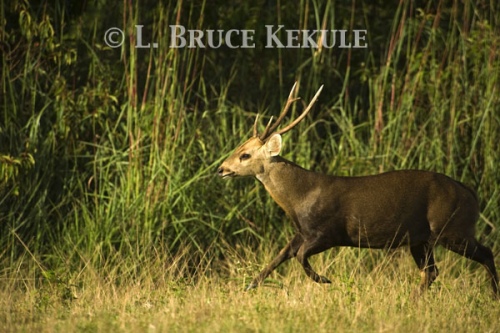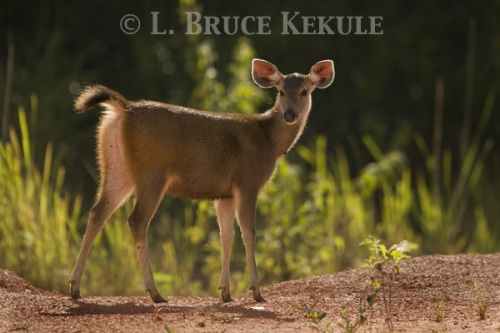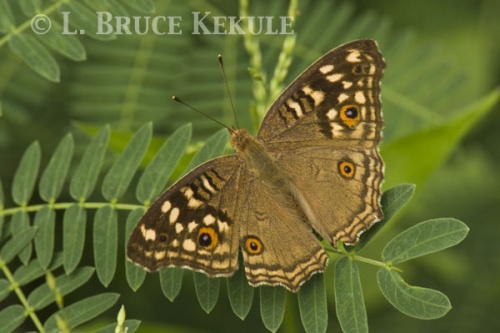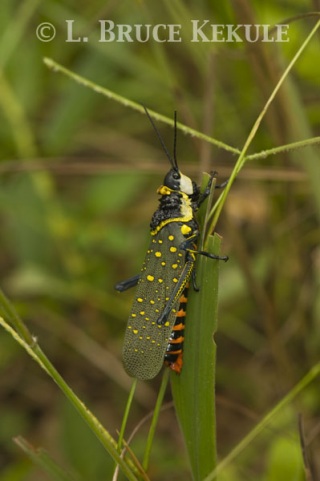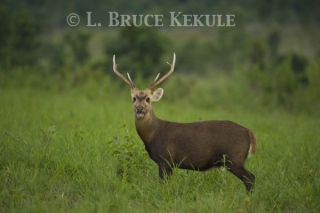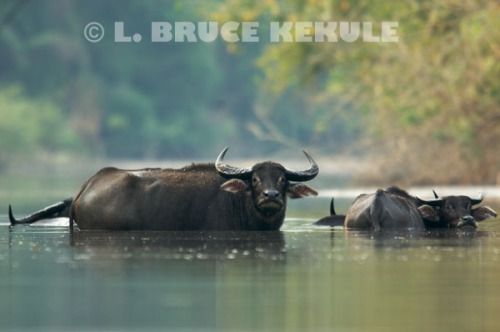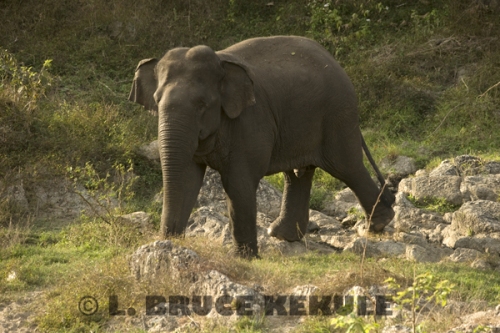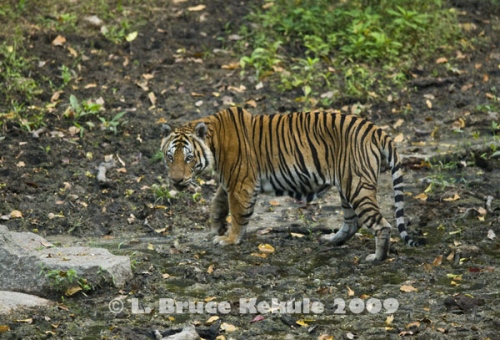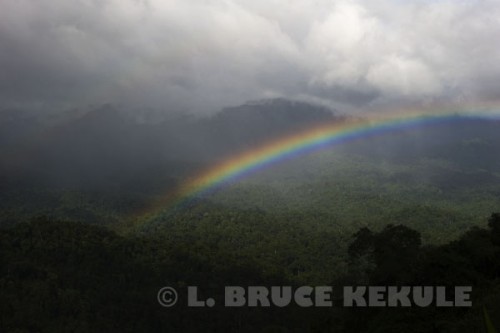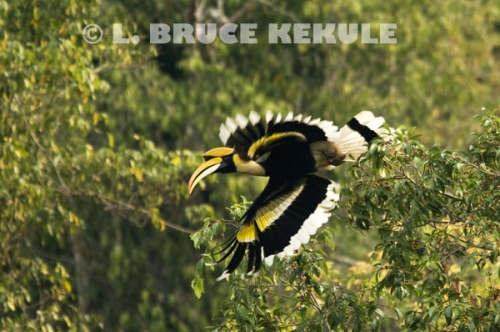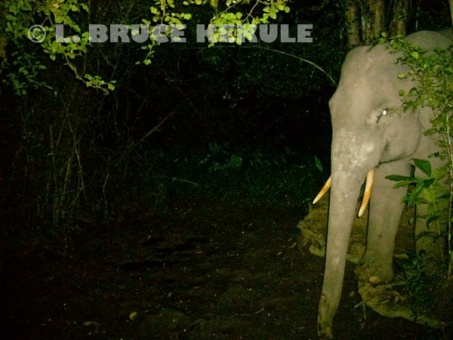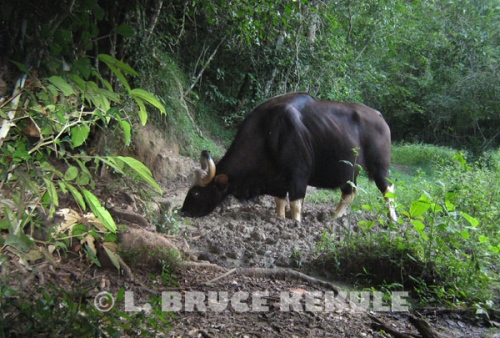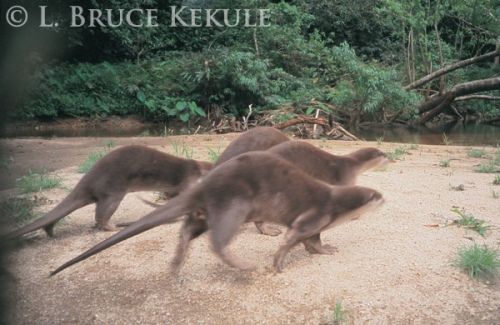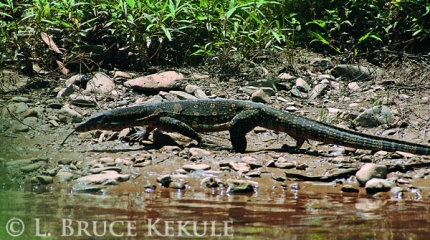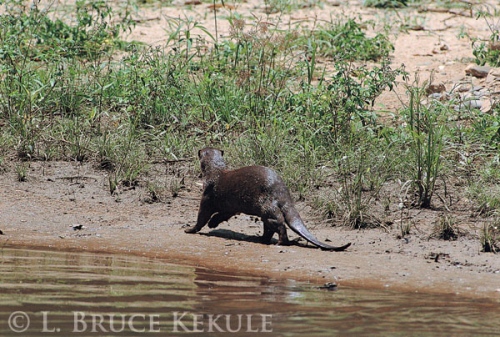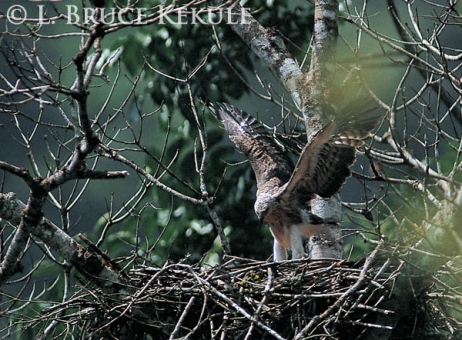Posts Tagged ‘forest complex’
Phu Khieo: Saving a species
Land of the plateau – pristine forest in the Northeast
Hog deer haven and introduction site
On Thai wildlife day, December 26, 1983, Her Majesty Queen Sirikit released four hog deer made up of two mature males and two females in breeding age at ‘Thung Kamang’ grassland in Phu Khieo Wildlife Sanctuary situated in the northeastern province of Chaiyaphum. This was the beginning of what is now a successful introduction program in order to save the species.
Hog Deer on the run in Phu Khieo Wildlife Santuary
The Crown Prince in 1987 introduced another four hog deer, and reintroduced several male and female sambar (Thailand’s largest deer) in the same area. In 1992, Her Majesty the Queen once again released more hog deer to boost the numbers of the herd. She also released three Eld’s deer (one male and two females). Unfortunately, this species has been difficult to monitor because of their preference for deep forest unlike the hog deer that prefer grassland and swampy habitat.
Phu Khieo massif
Over the years, the herd of hog deer has steadily increased due to a safe haven away from poachers and encroachment. In 2004, there were approximately 75 deer, and in May 2008, Kasetsart University conducted a survey around the grasslands and headquarters area counting more than 120 individuals. There are now approximately 140 hog deer in three or four separate herds. The sanctuary officials are constantly monitoring the herd with six hog deer fitted with radio collars and have established their range in the sanctuary.
It’s November and not a single cloud can be seen in the clear blue sky. Early morning air is crisp and cool. Heavy dew blankets Phu Khieo as mist rises from the forest. The sun arcs up into the sky and morning heat builds up. A mature sambar stag barks a warning call alerting all the animals within audible range that a predator is on the prowl. In the grasslands, a herd of hog deer grazing on tender young shoots is now on high alert. They are nervous and begin moving as the top carnivore of this forest stalks them.
Sambar yearling doe in late afternoon light
A pack of hungry Asian wild dogs working like a well-oiled machine concentrate on their target. They bump into the deer scattering them. The dogs go after an inexperienced doe and separate her from the herd. The chase is on. The deer becomes confused and makes a wrong turn. The dogs pull the struggling creature to the ground and go in for the kill. Within an hour the carcass is stripped and almost nothing is left except a few scraps. But it’s just another day in the balance of nature where natural selection and the struggle for life and death between predator and prey is played out.
In the early 1830s’ during the reign of King Mongkut, the French missionary Monsignor Jean-Baptiste Pallegoix, in his excellent book entitled ‘Description of the Kingdom of Siam’ published in 1850 reported seeing large herds of deer grazing on the central plains. Hog deer were still quite common in the Kingdom even at the turn of the 19th Century and could be found in all the river basins of the far North, the Northeast, the West and the whole of the Chao Phraya River basin and its tributaries. Hog deer fossils taken from sand dredging in many rivers dates back thousands of years to the Holocene, and teeth fossils of hog deer were discovered in a cave in Phu Khieo dating to the Pleistocene.
Hog deer buck and doe – the male has a radio collar
Unfortunately, these lowland deer were totally overcome by habitat destruction converting natural grasslands and swampy areas into agricultural land throughout the hog deer’s former range. Hunting deer was also a big business and warfare in Asia drove the skin trade. From the late Ayutthaya Period up to the early 20th Century, Siam exported millions of deer pelts from all the large species of deer including Schomburgk’s deer (extinct), sambar, Eld’s deer and hog deer to Japan. Deerskin being soft and supple was used to make leather for Samurai armor and clothing, boots and equipment mostly for the military. This was one of the main reasons for the disappearance of these remarkable creatures from the wild.
Short-nosed fruit bats
Captive breeding of hog deer, Eld’s deer, sambar and muntjac (barking deer) is carried out in some of the 22 wildlife breeding centers around the Kingdom set up by the Royal Forest Department, and now managed by the National Parks, Wildlife and Plant Conservation Department (DNP). The Phu Khieo Wildlife Breeding Center outside the sanctuary has been active since 1983 and is still breeding deer and wild pigs for future release into other wildlife sanctuaries and national parks.
Essarn is not all barren and dry like many people think. Over in the western part of the Northeast is Phu Khieo – Nam Nao Forest Complex that incorporates 19 protected areas, covering some 7,725 km2 (twelve national parks and seven wildlife sanctuaries) in the provinces of Chaiyaphum, Khon Kaen, Nong Bua Lum Phu, Udon Thani, Loei, Phechabun and Lop Buri. The complex incorporates a number of large forests on the Phetchabun and upper Dong Phayayen ranges. Phu Khieo, established in May 1972, is the largest sanctuary in the complex at 1,560 km2 made up of, a rocky plateau and steep mountains. The protected area is covered in forests of pine, deciduous, dry dipterocarp and evergreen with many streams that flow into the Chi, Lam Phrom and Sa Phung rivers.
Bird-eating spider
Phu Khieo has elephant, gaur, sambar, muntjac, mouse deer, tiger, clouded leopard, golden cat, back-striped weasel (extremely rare), black bear, gibbon, langur and macaque plus many other mammals can still found here. Jeffery McNeely found tracks in 1977 of the Sumatran rhinoceros on a mountain in the middle of the sanctuary. The last set of rhino footprints was recorded by the sanctuary staff some 10 years ago but has not been seen since. Crocodiles are thought to lurk in the backwaters but again, only footprints and feces have been discovered several years ago. These two species need further investigation and research to establish if they still exist, especially the rhino.
Rare birds such as the Oriental darter and white-winged duck live in the secluded wetlands found in this forest. Other birds include hornbill, osprey, black baza, blue pitta, Siamese Fireback, plus loads of babblers, flycatchers, barbets, kingfishers and other forest birds. The very rare purple cochoa has been sighted and photographed here.
Oriental Darter by the lake
Much research has been carried out by foreign and local researchers from various organizations. Stonybrook University in New York sent a team to monitor and record behavioral habits of the Phayre’s langur and crab-eating macaque. Lon Grassman, as a master student with Kasetsart University, did a camera-trap survey and, collared golden cat and clouded leopard plus other carnivores with support from Texas A&M University and he received his PhD from this excellent work. Kitti Kreetiyutanont who heads the Phu Khieo Research Station has done much research on biodiversity of flora and fauna found here, and in the buffer zone outside the sanctuary. He also has done some archaeology work finding pottery and tools thousands of years old. There are some cave drawings in the sanctuary indicating past civilizations. Wanchnok Suvarnakara, the deputy superintendant, is an avid wildlife photographer and has recorded many species on film and digital, and published a photographic book.
Pansi butterfly
For the first time in the history of wildlife sanctuaries since Salak Phra in Kanchanaburi was established in December 1965, a woman has been nominated as superintendant to Phu Khieo. Dr Kanjana Nitaya received a doctorate on management, and has run this protected area with determination to succeed. The staff and locals who have benefited from her management skills and leadership over the last four years respect her. In 2006, Phu Khieo was voted as the best wildlife sanctuary in all categories by DNP due to criteria established by the department. She is proud of this achievement and hopes this will help the conservation of this magnificent place well into the future.
Bombay locust
However, poaching and encroachment is still an on-going problem for the staff. Another serious long-term idea from politicians in the lowlands is to build a dam across the Sa Pung Nua River on the southern face of the plateau not far from Nong Bua Daeng in Chaiyaphum. If this dam were to become a reality, a large swath of forest would be inundated and damage the ecosystem already in jeopardy. All efforts should be made to stop this project before it goes too far. As Thailand’s best wildlife sanctuary, it should not be compromised by the construction of a man-made scheme.
Saving a species from extinction should be a top priority of the DNP. Other ungulates like goral, serow and banteng should be reintroduced into protected areas where they once thrived. Some may argue against introduction or reintroduction, but as we loose more and more species, release is a practical way to save Thailand’s rare animals from extinction in the wild. It is up to the department to instigate and increase these introduction/reintroduction projects, and then to protect these animals from danger by all means available. Budgets for enforcement and protection need to increase, and more staff to man any project to save a species from extinction is an utmost priority.
Hog deer buck in the grassland
Historically, the range of the hog deer spread from India and Nepal, east through Burma and Thailand, to Laos, Cambodia and Vietnam. This deer is now restricted to just fragments of its former range. In Thailand, the last sighting of hog deer was in Nong Khai province in the Northeast sometime during November 1963. There are some hog deer herds in the wilds of Cambodia and Laos.
Hog deer were typically found on alluvial plains and lowland forest along rivers, particularly near marshes with tall grass. Today it would be impossible to reintroduce these deer into any of their former habitat, but a few protected areas like Phu Khieo are ideal. Any introduced or reintroduced species needs the full protection afforded by a national park, wildlife sanctuary or non-hunting area.
Hog deer are medium-sized animals that resemble the larger and more common sambar deer in appearance. Male hog deer antlers are similar in shape as sambar but smaller. Depending on the season, they have grayish to dark brown fur. Females like all other deer species, have no antlers. Fawns have spotted coats. Spots can also be clearly seen on some adults.
These deer are more of a grazer than a browser and feeds on grass. They are gregarious, forming large family groups. The rut starts in September and goes on through October. A single fawn is born eight months later, during the rainy season around July or August. Hog deer received their name because of the way they move. Unlike other deer, they seldom jump over a bush or high grass, but they tend to run through the underbrush with head held low to the ground, much like a hog.
Kaeng Krachan: Jewel in the Tenasserim Range
One of the Kingdom’s Last Great Tiger Reserves: Thailand’s Largest National Park and Biodiversity Hotspot
Just a short forty years ago, a local Karen hunter sitting alone in a tree-stand made of bamboo waits by the headwaters of the Phetchaburi River. He has trekked south from his humble abode for about a week. This young man is a traditional hunter and knows how to subsist by himself in this forbidding forest. His father before him also hunted this place and taught him all the tricks-of-the-trade: hunting for a living and surviving in the wild.
Rainbow over the Phetchaburi River
Darkness envelopes the man as the sun sets behind him. The moon and stars are brilliant and night visibility is good. The location is a mineral deposit (salt lick) deep in the interior close to the river. This site attracts gaur, banteng, elephant, and the extremely rare Sumatran rhino, plus sambar, muntjac and wild pigs. Tigers and leopards also came looking for prey. It was a magnificent animal kingdom.
Serow camera trapped on old logging road
His primary target was the rhino but would take anything that came to the natural seep for the life-giving minerals. The hunter sets in for the night knowing the large mammals sometimes prefer to visit in darkness. He is armed with a crude self-made muzzle-loading rifle. It is the dry season, and he is not too worried about a misfire. The caliber is as large as his thumb, and the round heavy lead ball and black powder charge is enough to take down an elephant.
A great hornbill lifting off a fruit tree
At last, a dark shape emerges from the forest and slowly ambles straight to the seep. Head down, the odd-toed ungulate drinks to quench its thirst. The hunter switches on his flashlight and temporarily blinds the two-horned rhinoceros. He takes aim and fires his weapon with a resounding boom and tremendous muzzle flash that breaks the still night. The creature is hit in the shoulder and runs for a short distance before collapsing. It is a long wait but dawn eventually comes and the hunter climbs down from the platform to investigate his trophy. Sadly, he just killed one of the last few Sumatran rhinos left in this forest.
Indochinese tiger caught by camera trap by the Phetchaburi River
Shortly hereafter, he dispatched another rhino and then never saw the species again. He sold the horns, which were small, for about 100 U.S. dollars to a waiting middleman: a pathetic return compared to what the horns probably fetched on the black market which was most likely in the thousands of dollars. This voracious wildlife trade has absolutely wiped out many species from the forests throughout the Kingdom. It has been devastating and unfortunately, still carries on to this day.
Indochinese tiger camera trapped at a mineral lick
When Kaeng Krachan was declared a national park in 1981, the hunter, his family and several other families in the little village were relocated more than twenty kilometers outside the boundaries of the protected area. A plot of land was given to them but it was not to much, probably just sustainable. He was told that he could not hunt anymore and had to eke out a living by farming. It was a difficult road ahead for them after living in the forests since they were born. Relocation was tough but they adapted and survived. The hunter and his family now plant pineapples and other crops. He stopped hunting, and his two sons actually care about conserving the forest and wildlife.
Bull elephant camera trapped at a mineral deposit
The Phetchaburi is one of Thailand’s most famous waterways. King Rama V visited this waterway and His Majesty had water sent to his palace in Bangkok for drinking purposes. The King was also presented with rare white elephants found here. During his reign, both Sumatran and Javan rhinos existed in the interior in good numbers.
Tiger camera trapped by the Phetchaburi River
In 1914-1915, an Englishman named K.G. Gairdner made many forays into the Phetchaburi watershed recording the wildlife. He published several papers in the Natural History Society of Siam about his exploits and encounters in this wilderness. Large herds of elephants and gaur were present and many tigers thrived due to the prolific amount of prey species.
Tiger camera trapped by the Phetchaburi River
The Phetchaburi River flows from the Tenasserim Range through Kaeng Krachan, the Kingdom’s largest national park encompassing 2,915 square kilometers (1,125 square miles). It is still pristine within some areas of the park. Montane forest is found on the highest peaks with predominantly dry evergreen forest interspersed with mixed deciduous vegetation. Even though both species of rhino have disappeared, the park continues to showcase a great diversity of wildlife.
Gaur camera trapped at a mineral lick
Rare and endangered animals still survive such as the Siamese crocodile and stumped-tailed macaque as well as elephant, gaur, tiger, leopard, Asian wild dog, tapir, sun bear and Asiatic black bear. Other mammals such as sambar, and the rare Fea’s muntjac plus common muntjac and wild pig keep the balance of nature intact by providing ample prey for the carnivores. Banteng were common in the mixed deciduous lowlands but humans encroaching on the forest soon eliminated most of these wild cattle and there are very few remaining if any at all.
Gaur herd spooked by camera trap
However, the Phetchaburi is still an important watershed and is the main source of water for people on the lowlands. Hornbills and gibbons are plentiful. I once listened to four separate gibbon groups calling at the same time from Phanern Thung Mountain. The surrounding forest contains fertile food in abundance and safe habitats for all the wild animals. Both Sundaic and Indo-Chinese species survive here.
Gaur cow camera trapped at a mineral deposit
The Phetchaburi is one of the Kingdom’s least disturbed waterways and although the lower section is dammed, the upper reaches of the river are still fairly intact. More than 400 bird species have been recorded in Kaeng Krachan and thousands of unusual plant and insect species can be found. There are more than 70 species of fish in the waterway. Many reptiles including the king cobra and reticulated python, and amphibians like the giant tree frog are here. There are probably some species new to science still to be discovered, specially insects and plants.
Additional animals found in Kaeng Krachan National Park:
Siamese crocodile in the Phetchaburi River
Lone Siamese croc in the river
Smooth-coated otters camera-trapped by the Phetcahburi River
Water monitor hunting for prey by the Phetchaburi River
Smooth-coated otter hunting by the Phetchaburi River
Smooth-coated otter jumping into the Phetchaburi River
Lesser fish-eagle by the Phetchaburi River
Lesser fish-eagle chick in a nest above the Phetcahburi River
Crocodile pond in the Phetchaburi River


